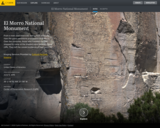
1722 CE - 1956 CE, Tracing the footsteps of slavery on a Danish sugar plantation
- Subject:
- Architecture
- Arts and Humanities
- CTE
- World history
- Date Added:
- 06/06/2017


1722 CE - 1956 CE, Tracing the footsteps of slavery on a Danish sugar plantation

1901 CE - 1917 CE, Antarctic Expedition Huts

140 CE - 160 CE, The Northernmost Frontier of the Roman Empire

1900 BCE - 606 BCE, 2,500 years after the collapse of the Assyrian Empire, beginning in the 18th century and reaching a height in the 19th century, England led many archaeological excavations and studies throughout Iraq, rediscovering a long forgotten civilization. Through these studies, architectural layouts, deciphering of the diverse cuneiform scripts, and an understanding of this ancient empire came to light. Held at the British Museum, these vast objects continue to inspire viewers, reminding them of the power once held and adding to the greater understanding of our collective past.

1917 CE - 1920 CE, Hangar Montato

2000 BCE - 150 BCE, A Monument of the "Cradle of Civilization" , The city of Babylon is one of the most important archaeological sites in the world. Located alongside the Euphrates River in modern-day Iraq, its monumental ruins recall the history of Mesopotamia, the ancient Near East, and the Biblical Old Testament, nestled in the region that is considered the cradle of civilization.

10th - 14th Century CE, Bagan is an ancient city located in the Mandalay Region of Myanmar. From the 9th to 13th centuries, the city was the capital of the Pagan Kingdom, the first kingdom that unified the regions that would later constitute modern Myanmar.

1959 CE - 2014 CE, Beth Sholom Synagogue, a House of Peace

1932 CE, The Blue Wing Inn in Sonoma, California, was one of the first hotels built in the state north of San Francisco

1788 CE - 2017 CE, The physical representation of an evolving German identity

1350 CE - 1788 CE, Frescoed Ceiling of a Medieval Church

900 BCE - 146 BCE, The amphitheaters found around the Mediterranean are one of the most important legacies left from ancient civilizations. Their architecture, acoustics, and quality of structure give clue to their social importance and craftsmanship. As important as they were historically, they are equally as important now to the living legacy from tourists to local performers. However, it is also this continued interest that has become a contributing factor to the deterioration of these sites. ATHENA Project

1226 CE - 1575 CE, Vaulting, Gothic Cathedral in France

1500 BCE - 300 BCE, Ancient Peruvian Mountain City at 11,000 Feet - Located in the Peruvian Andes, ChavÃÂÂn de Huántar was the strategic capital and religious center of the pre-Inca, ChavÃÂÂn civilization. The project team from the University of California at Berkeley traveled to ChavÃÂÂn to digitally preserve this important site. The project's goal was to support and supplement archaeological activities and research being conducted by Stanford University with the intent of the new data becoming the foundation for an on-site conservation plan.

600 CE - 1221 CE, Ancient Mayan City of the Yucatan

1466 CE - 1712 CE, The First European Slave Port

1876 CE - 1910 CE, Wild West Town in South Dakota

1636 CE - 1688 CE, Imperial Tombs of the Qing and Ming Dynasties

1906 CE, From a main east-west trail, dating from antiquity, rises the great sandstone promontory of El Morro. Over the centuries, those who traveled this trail stopped to camp at the shaded oasis beneath these cliffs. They left the carved evidence of their passing - symbols, names, dates, and fragments of their stories that register the cultures and history intermingled on the rock. Explorers and travelers have known of the pool by the great rock for centuries. A valuable water source and resting place, many who passed by inscribed their names and messages in the rock next to petroglyphs left by ancient Puebloans. The ruins of a large pueblo located on top of El Morro were vacated by the time the Spaniards arrived in the late 1500s, and its inhabitants may have moved to the nearby pueblos in Zuni and Acoma. As the American West grew in population, El Morro became a break along the trail for those passing through and a destination for sightseers. As the popularity of the area increased, so did the tradition of carving inscriptions on the rock. To preserve the historical importance of the area and initiate preservation efforts on the old inscriptions, El Morro was established as a national monument by a presidential proclamation on December 8, 1906.

1847 CE - 1923 CE, Churches of Antebellum North Carolina